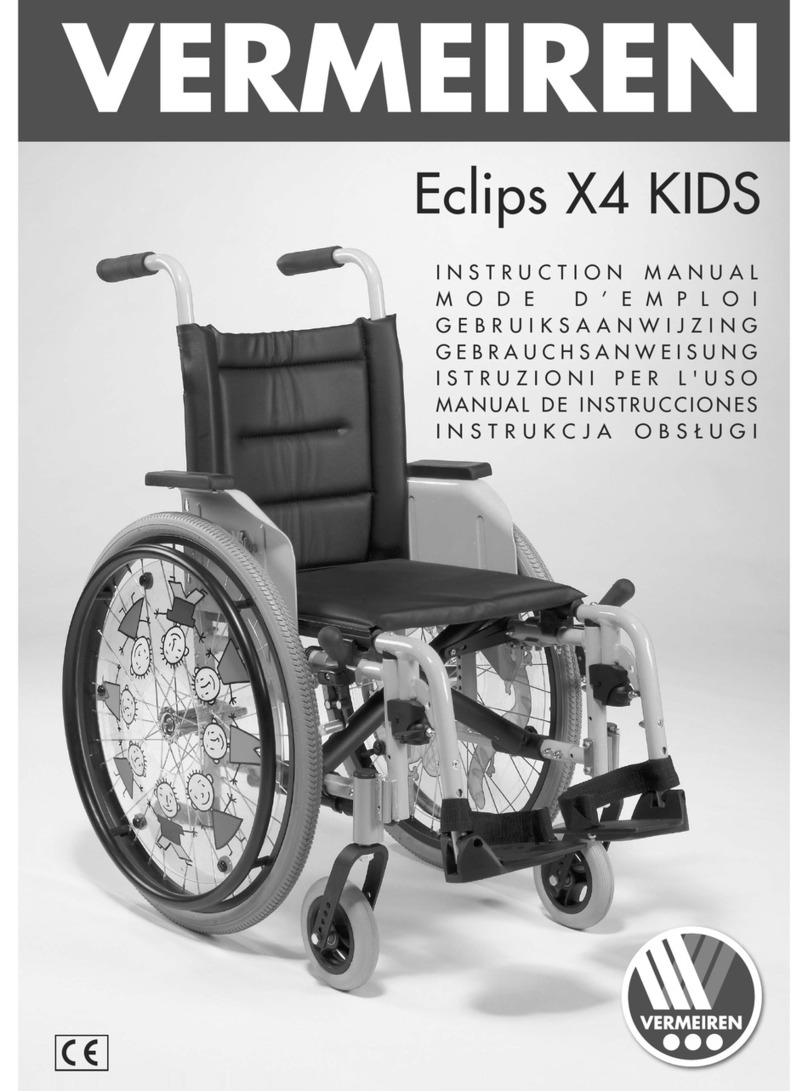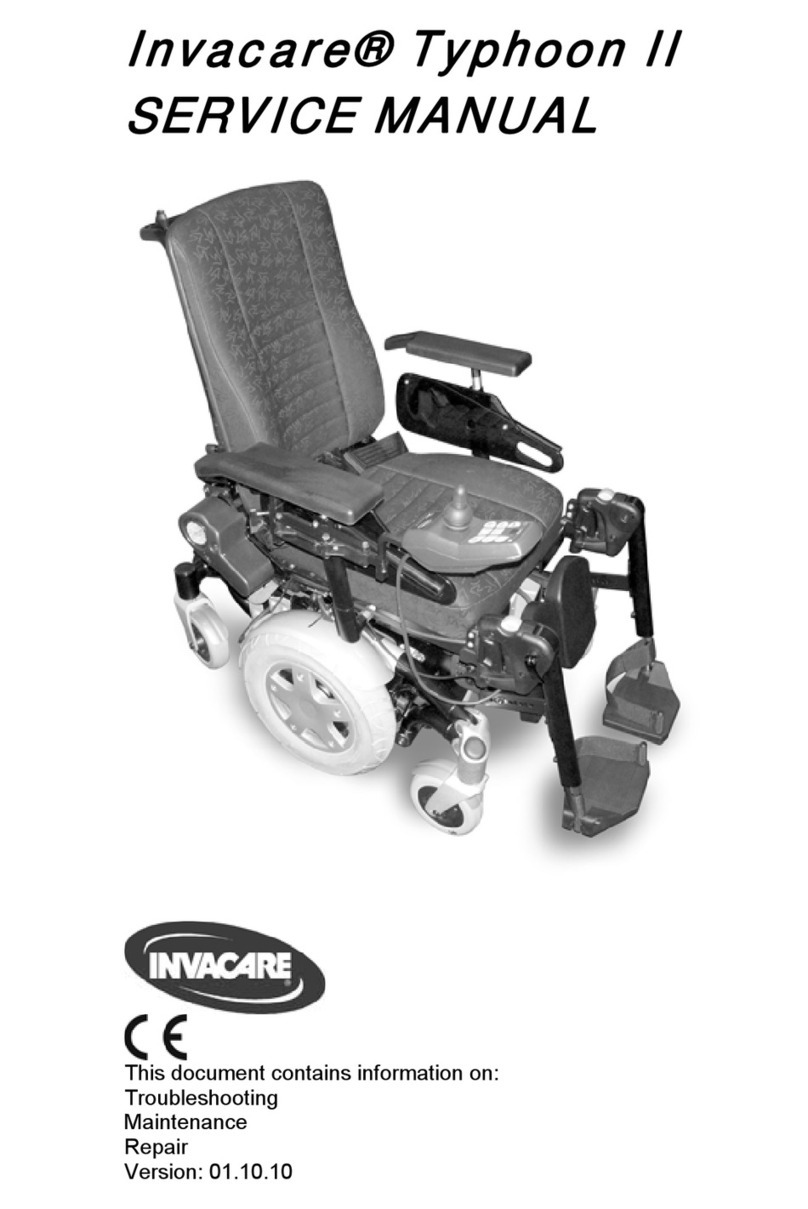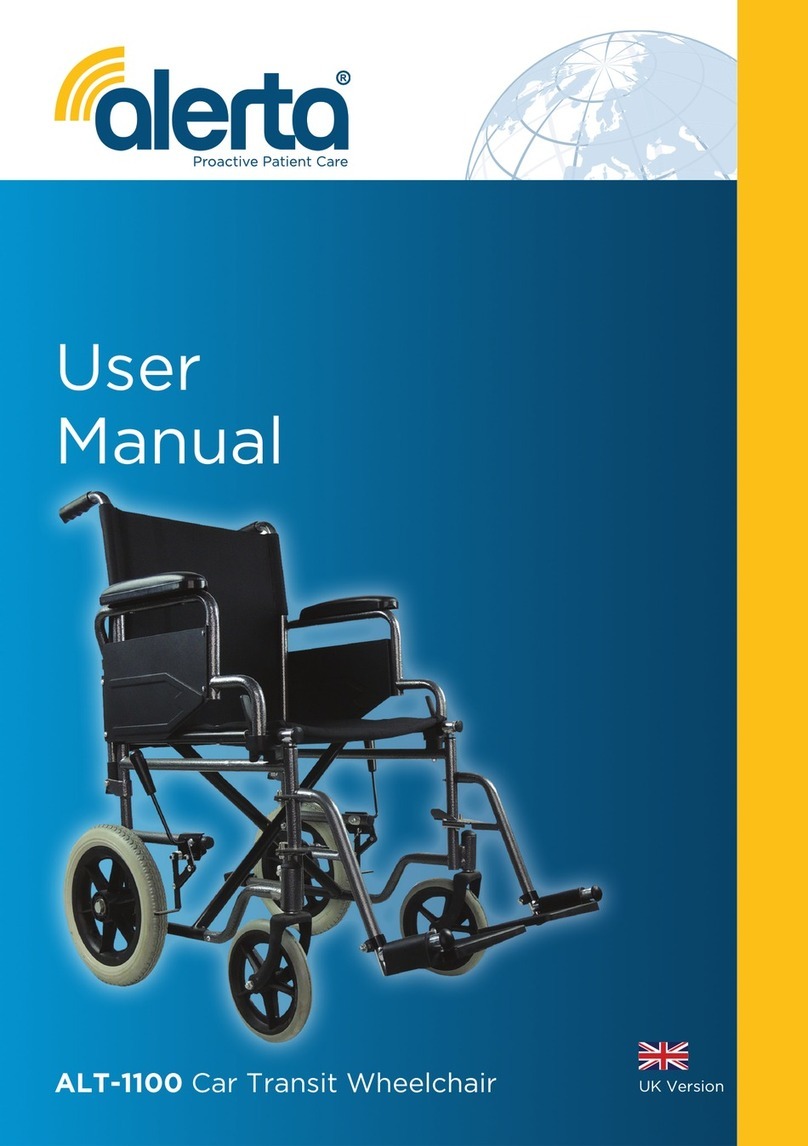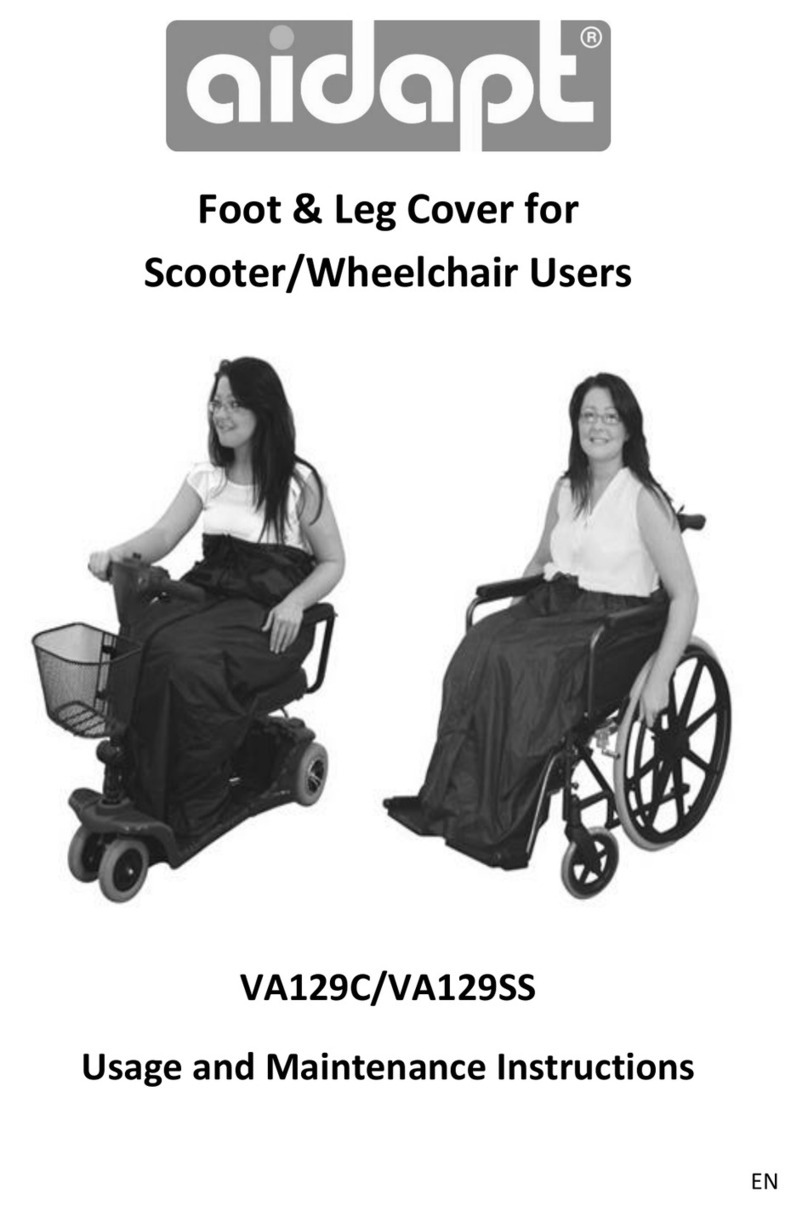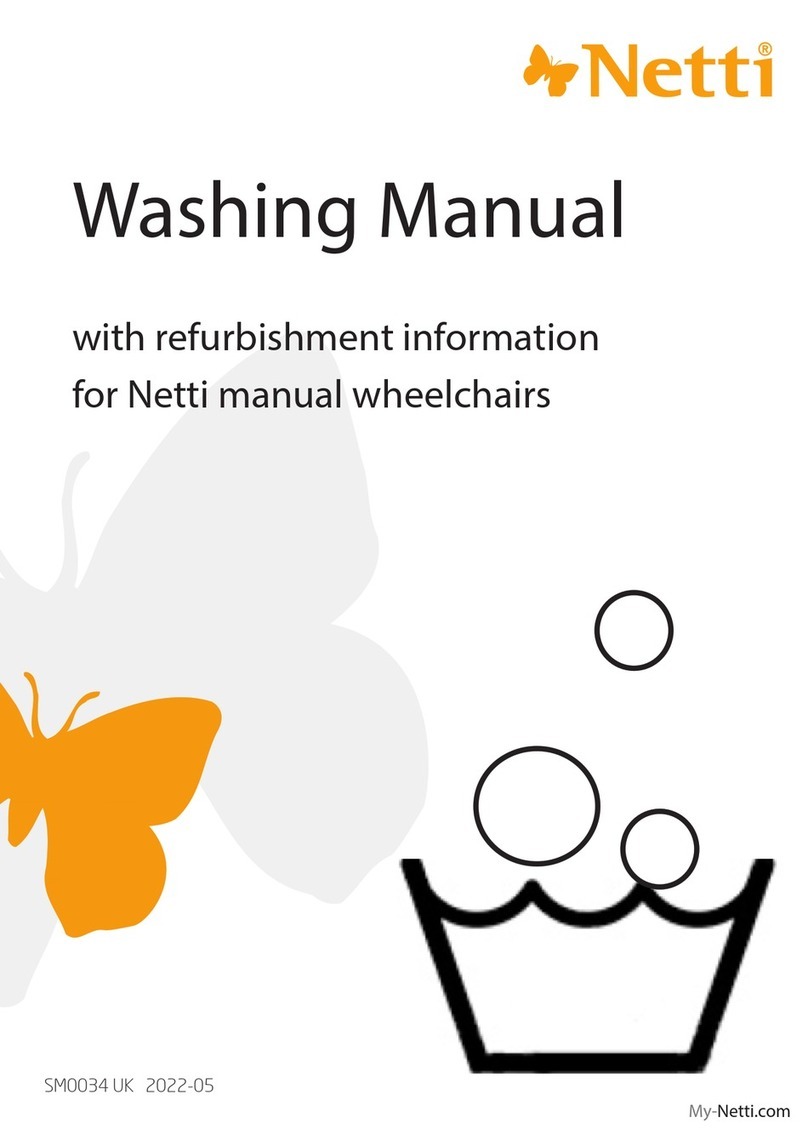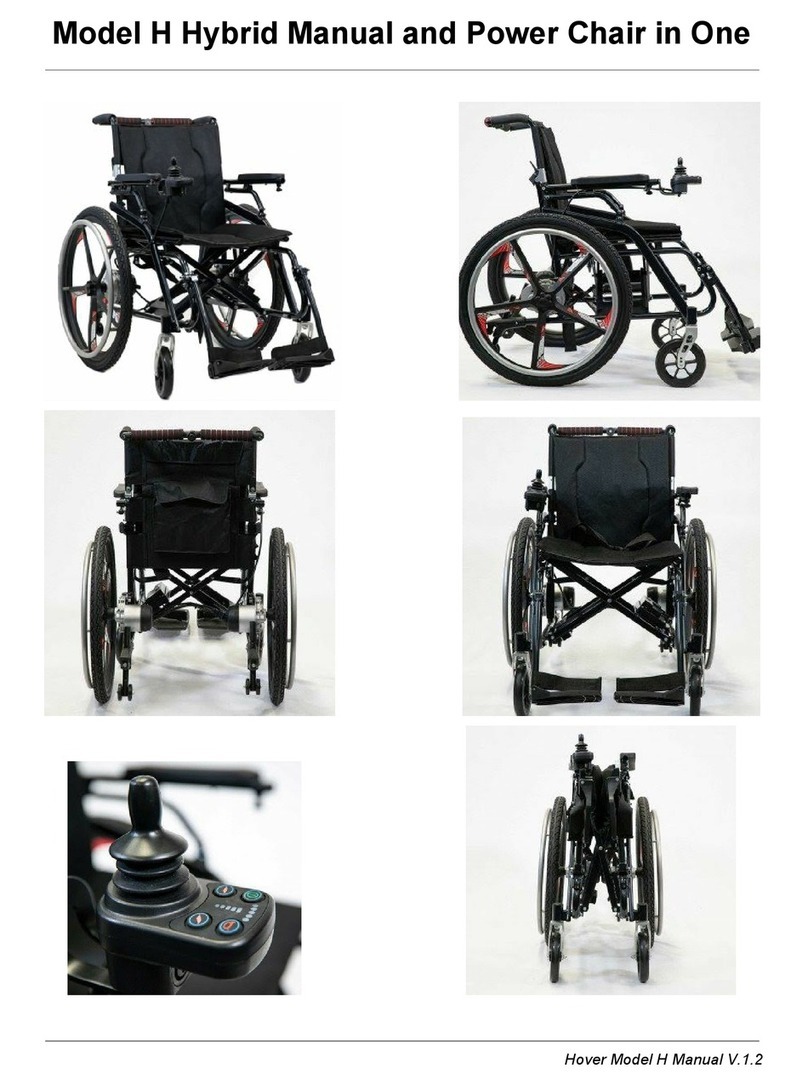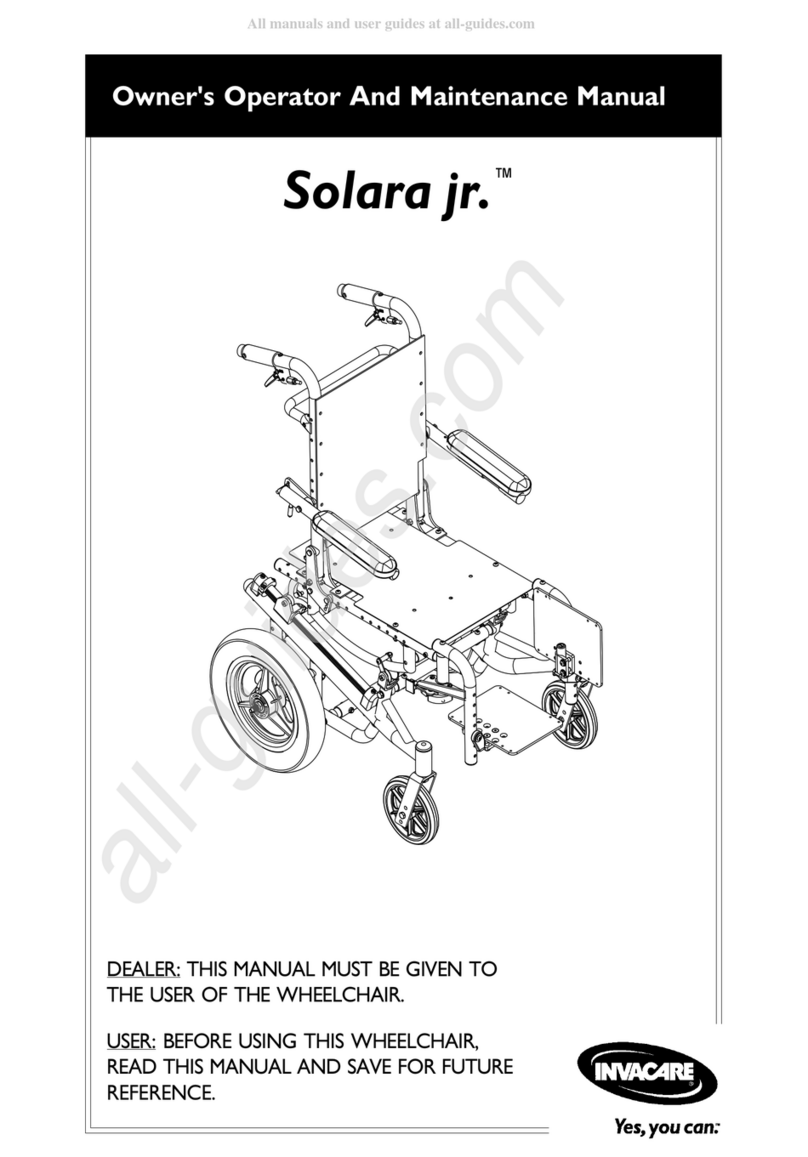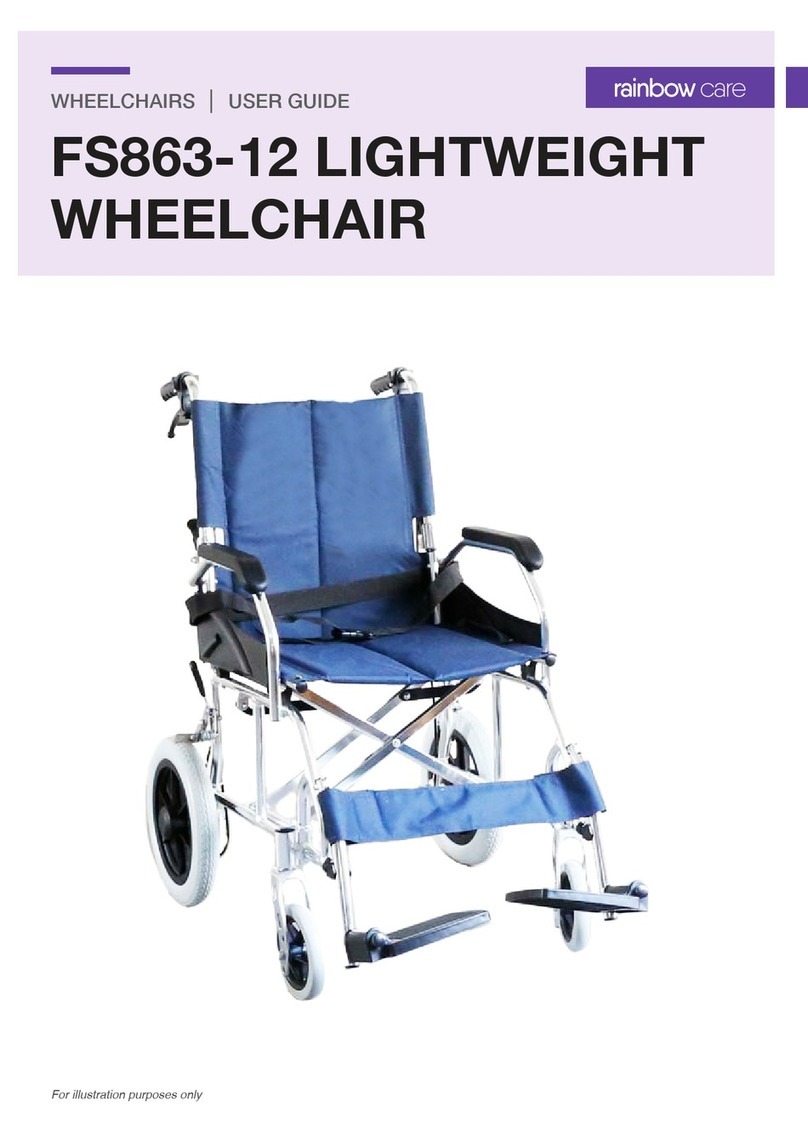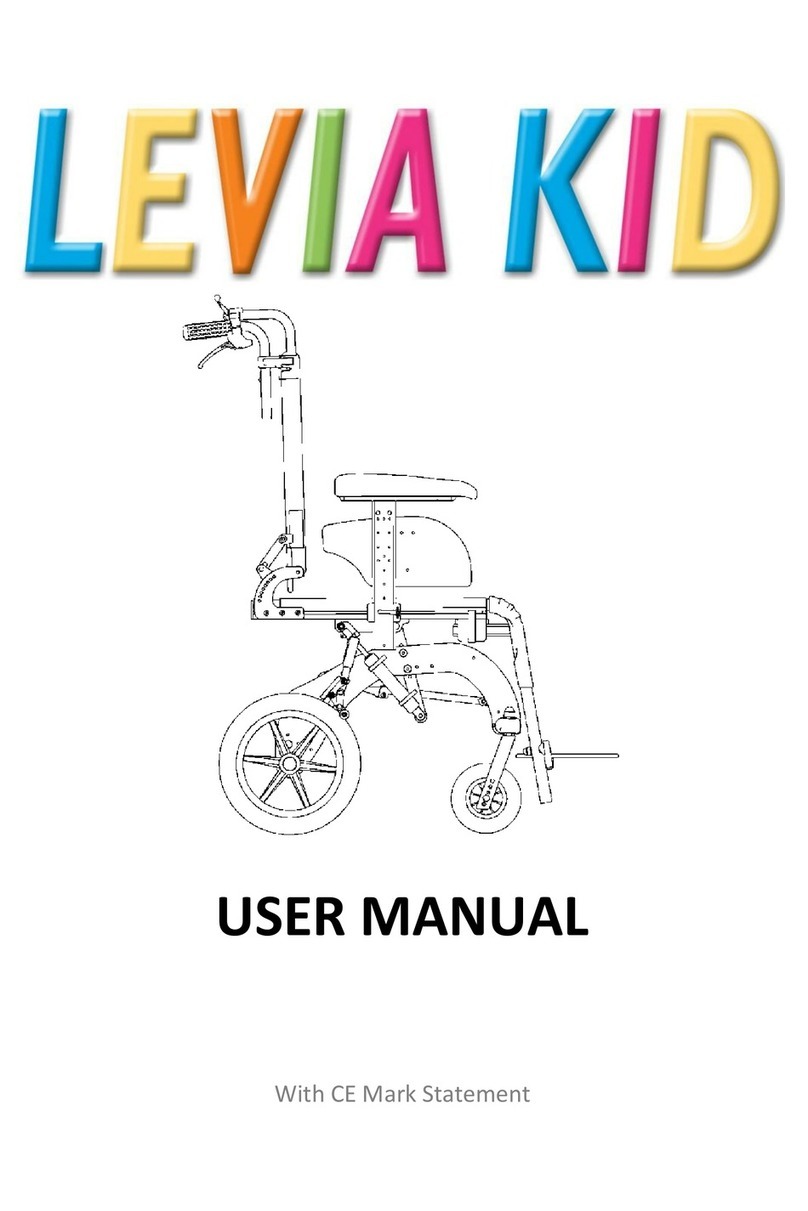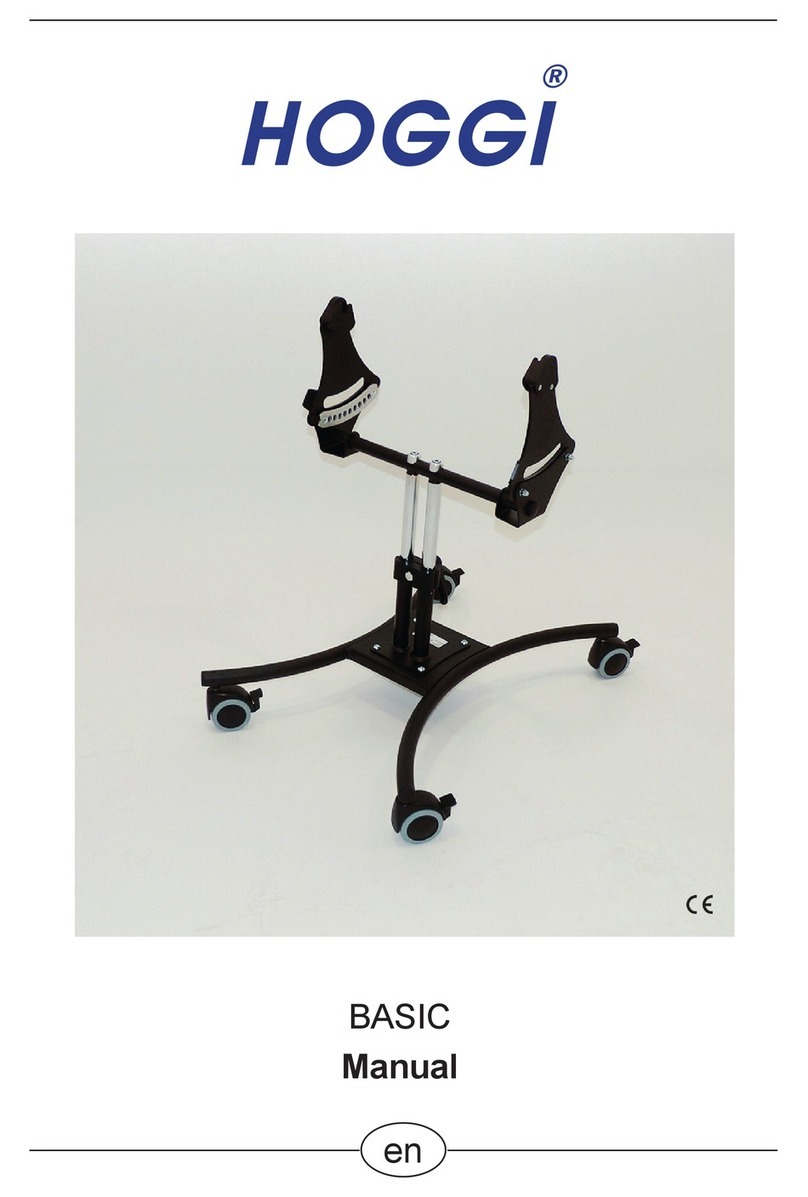Roltec Vision plus User manual

version 1.03
Kontakt vest for Storebælt:
ROLTEC el-kørestole A/S
Lægårdsvej 13
DK - 8520 Lystrup
Telefon +45 87 43 49 00
Telefax +45 87 43 49 29
ROLTEC el-kørestole - vi udvikler for dig
Kontakt øst for Storebælt:
TA•SERVICE A/S
Orupgade 32B, Orup
DK - 4640 Fakse
Telefon +45 56 72 57 77
ROLTEC el-kørestole A/S tilbyder et bredt program af indendørs- og
udendørs el-kørestole, der er unikke, når det gælder kvalitet, design
og funktionalitet.
Vi følger hele tiden med udviklingen og har netop lanceret en ny og
brugervenlig styreboks med udgangspunkt i den nyeste teknologi.
Bestil tid til en demonstration af en ROLTEC el-kørestol – en oplevelse
i funktion og komfort.
designconcern.com
User’s instructions for model VISION plus
valid from and including CU soft 0101.00.01
C
ategory
ategory
B
A
rticle
number: 50074


F o r e w o r d
ROLTEC el-kørestole A/S congratulates you on your new ROLTEC VISION plus wheelchair, and would like to thank you
for the confidence you have shown in us by choosing our product.
ROLTEC el-kørestole A/S is one of the leading suppliers of electric wheelchairs on the market, both with regard to tech-
nical status and subsequent service.
Your ROLTEC VISION plus electric wheelchair is equipped with up-to-date controls, whose construction and functions
were designed on the basis of the more than 30 years of experience possessed by ROLTEC el-kørestole A/S, supple-
mented by the requests and demands of occupational therapists, physiotherapists, and users.
Our goal was to create a microprocessor control system that functioned very easily and was simple to operate, yet so
advanced that it enabled individual adaptation so that it would have the functions and road-holding properties that suit
you best.
These user’s instructions contain the information you need to operate the wheelchair. If you have any questions that
have not been answered in these instructions, you are always welcome to contact your ROLTEC distributor..
As ROLTEC el-kørestole A/S carries out ongoing product development, we reserve the right to make changes to specifi-
cations.
The CE label indicates that the wheelchair complies with the Danish Ministry of Health regulation no. 92 of 7 February
2000.
The wheelchair has been tested in accordance with the EN12184:1999 standard at Hjälpmedelinstitutet in Stockholm
(Swedish Centre for Technical Aids for Rehabilitation and Education). Delta EMC carried out an accredited test in
pursuance of EMC requirements.
We would draw your attention to the fact that any changes made by the user in the control parameters and other set-
tings are at the responsibility of the user!
These user’s instructions were prepared in accordance with current demands.
Foreword
Side 3

Page 4
Table of contents
Foreword:
Table of contents:
Picture of control box:
Operating the wheelchair
General principles:
Start:
Menu:
Stop:
Lights:
Horn:
Pushing the wheelchair:
Charging the batteries:
Operating electrical components:
Seat tilt:
Seat lift:
Electric back rest:
Electric leg supports:
Lights:
Choice of driving parameters:
Setting the speed:
Setting the brakes:
External operating box:
Helper control:
Fault displays:
Transport in general:
Road transport:
Air transport:
Warning:
Page 4
Warning:
Page 4
Model information:
Page 4
Model information:
Page 4
3
4
8
8
9
10
10
10
10
11
12
12
12
13
13
14
14
14
15
16
16
17
17
17
18
18
18
6
-----------------------------------------------------------------------------------
General principles:
-----------------------------------------------------------------------------------
General principles:
---------------------------------------------------------------------
Operating electrical components:
---------------------------------------------------------------------
Operating electrical components:
-----------------------------------------------------------------------------------
Charging the batteries:
-----------------------------------------------------------------------------------
Charging the batteries:
-----------------------------------------------------------------------------------
Pushing the wheelchair:
-----------------------------------------------------------------------------------
Pushing the wheelchair:
-----------------------------------------------------------------------------------
Horn:
-----------------------------------------------------------------------------------
Horn:
-----------------------------------------------------------------------------------
Lights:
-----------------------------------------------------------------------------------
Lights:
-----------------------------------------------------------------------------------
Stop:
-----------------------------------------------------------------------------------
Stop:
-----------------------------------------------------------------------------------
Menu:
-----------------------------------------------------------------------------------
Menu:
-----------------------------------------------------------------------------------
Start:
-----------------------------------------------------------------------------------
Start:
-----------------------------------------------------------------------------------
Seat tilt:
-----------------------------------------------------------------------------------
Seat tilt:
-----------------------------------------------------------------------------------
-----------------------------------------------------------------------------------
-----------------------------------------------------------------------------------
-----------------------------------------------------------------------------------
-------------------------------------------------------------------------
-----------------------------------------------------------------------------------
-----------------------------------------------------------------------------------
Setting the brakes:
-----------------------------------------------------------------------------------
Setting the brakes:
-----------------------------------------------------------------------------------
-----------------------------------------------------------------------------------
-----------------------------------------------------------------------------------
-----------------------------------------------------------------------------------
-----------------------------------------------------------------------------------
-----------------------------------------------------------------------------------
-----------------------------------------------------------------------------------
-----------------------------------------------------------------------------------

Page 5
Table of contents
Settings
Settings
Mechanical settings:
Individual electronic system settings:
Steering parameters:
Clock:
Horn, volume:
Click volume:
Choice of colours:
Locking the wheelchair:
Maintenance
Removing the cover:
Wheels and tyres:
Punctures:
Front wheels:
Rear wheels:
Batteries:
Control box:
Seat:
Belts:
Antitip:
Cleaning:
Ordering spare parts:
Disposing of the wheelchair:
Fuses:
Data
Technical data for ROLTEC VISION plus:
Address list:
20
22
23
23
24
24
25
25
36
40
-----------------------------------------------------------
-----------------------------------------------------------
-----------------------------------------------------------
-----------------------------------------------------------
-----------------------------------------------------------
-----------------------------------------------------------
-----------------------------------------------------------
-----------------------------------------------------------
-----------------------------------------------------------
-----------------------------------------------------------
-----------------------------------------------------------
-----------------------------------------------------------
-----------------------------------------------------------
-----------------------------------------------------------
-----------------------------------------------------------
-----------------------------------------------------------
-----------------------------------------------------------
-----------------------------------------------------------
-----------------------------------------------------------
-----------------------------------------------------------
-----------------------------------------------------------
-----------------------------------------------------------
-----------------------------------------------------------
27
30
30
30
30
31+36
31
31
31
32
32
32
32
33
---------------------------------------------------

Page 6
Operating the wheelchair
Minus
On/Menu
Joystick
Horn
Turn off/Stop
Display
Plus
CONTROL BOX
Lights

Page 7
Operating the
wheelchair
Operating the wheelchair

Page 8
General principles of the wheelchair’s electrical functions:
General principles of the wheelchair’s electrical functions:
The wheelchair is switched off when the display is not lit, and switched on when the display is lit.
The wheelchair control system will be in one of two modes – either ready to be driven, or in a mode where in cannot
be driven, but where it is possible to operate all of the electrically powered functions of the wheelchair – leg supports,
seat lift, etc. – and make various adjustments to the wheelchair with the help of the joystick,
Starting:
Starting:
The wheelchair is switched on by pressing the menu button. When the wheelchair is switched on, it will always be in
ready to drive mode. Before beginning to drive the wheelchair, its top speed must be set on the horizontal bar at the
bottom of the display. Top speed is set with the help of the minus (-) and plus (+) buttons. The longer the bar extends,
the higher the top speed. It is still possible to drive the wheelchair slowly by moving the joystick slightly between neutral
position and top speed, even though top speed may have been set at maximum.
Begin carefully with a short horizontal bar until you have become accustomed to the way in which the wheelchair reacts
Begin carefully with a short horizontal bar until you have become accustomed to the way in which the wheelchair reacts
to the movement of the joystick.
to the movement of the joystick.
Operating the wheelchair
Operating the wheelchair
Operating the wheelchair
For reasons of safety, the speed of the wheelchair will automatically be reduced when reversing.

Page 9
Menu:
When you want to use the joystick for all the other functions in addition to driving, you can change from driving mode
to a choice of the other functions by pressing the menu button.
When you select the menu, the display will show which electrically operated functions you can activate. Functions are
activated by moving the joystick forwards or backwards. If the wheelchair function you want to activate does not appear
on the display, you can browse forwards to the required function by moving the joystick to the right or left.
You can also use the same browsing function with the help of the minus (-) and plus (+) buttons.
In addition to the displays that control the electrically operated wheelchair functions , there are three other displays:
1. Speed (not always shown)
2. Driving style
3. Settings
4. Brake settings
Operating the wheelchair
These displays are explained in the section on individual adjustments of the control parameters as they are used to
enter individual wheelchair settings to meet your needs.
Each time you press the menu button, the control box will change from driving mode to a mode where you can choose
the other functions.
It is always possible to return to driving mode by pressing the menu button, irrespective of where you are in the menu
items.

Page 10
Lights:
Lights:
Find the display LIGHTS. The lights will be switched on when the joystick is pushed forwards, and switched off when it
is pulled backwards.
The lights can also be switched on in driving mode by pressing the light button.
Horn:
Press the horn button on the control box (will only work when the wheelchair is switched on).
Pushing the wheelchair:
Pushing the wheelchair:
-
Warning
Warning
! :
If it is necessary to push the wheelchair, the ”push” function can be activated by turning the plastic handle on the back
of the wheelchair anti-clockwise. The display will now show BRAKE LIFTED and blink together with the wheelchair lights
to warn you that all of the wheelchair’s brakes are inactive in that state, and that the wheelchair’s motors are disenga-
ged. As the wheelchair’s brakes are inactive, the wheelchair may present a danger on slopes as it can roll of its own
accord.
Operating the wheelchair
Stop:
Stop:
Pressing the stop button will switch off the wheelchair and activate the automatic parking brake.
The stop button also functions as an emergency stop.
of the wheelchair anti-clockwise. The display will now show BRAKE LIFTED and blink together with the wheelchair lights
Remember to switch off the wheelchair if it will be parked for any length of time without the batteries being charged as
if the batteries are allowed to run down completely, they may be damaged.

Page 11
Charging the batteries:
Charging the batteries:
Battery voltage is shown on the left side of the display when the wheelchair is in driving mode. It is shown as a column
made up of small blocks. When battery voltage falls to the first block, the word CHARGING will blink and the batteries
must be charged.
The wheelchair batteries should be charged every evening so that they are fully charged every morning. They should be
charged for at least eight hours in a ventilated room.
The charging socket is located at the top of the right-hand frame on the wheelchair. The battery charger plug must be
inserted diagonally from above and tilted down to horizontal position.
The wheelchair cannot be switched on as long as it is attached to the charger. The charger shows when the batteries
have been fully charged (see instructions for battery charger).
After the batteries have been fully charged, remove the charging plug and the wheelchair can now be switched on in
the normal way.
A range of approximately 40 km can be expected after charging.
Operating the wheelchair
Battery voltage must never fall below block zero as this may permanently damage the batteries. The battery guarantee
will be annulled if the batteries are allowed to run down fully.
First connect the battery charger to a 220 V plug. Then put the battery charger plug into the charging socket on the
wheelchair.
If the wheelchair is not in use for longer periods of time, the batteries must be charged regularly, or they will be dama-
ged. This can be done by always having the charger switched on and connected to the wheelchair so that the batteries
will be automatically charged when necessary.
made up of small blocks. When battery voltage falls to the first block, the word CHARGING will blink and the batteries

Page 12
Operating the wheelchair’s electrically operated components:
Operating the wheelchair’s electrically operated components:
The electrically operated components in question can be found by browsing forwards or backwards through menu
items on the display. The display will show only the electrically operated components that your wheelchair is equipped
with, and no others.
The wheelchair is normally equipped as standard with the following electrically operated components:
Seat lift
Seat tilt
Mono leg support
Electric leg support, left
Electric leg support, right
Leg supports, right and left
Electric back rest
Seat lift:
Find the display SEAT LIFT . Pulling the joystick backwards will lift the seat and pushing it forwards will lower the seat,
as shown by the arrows on the display.
The seat lift can lift you 31 cm above the lowest position. When the seat is lifted more than 18 cm above the lowest
position, the maximum speed of the wheelchair will be reduced automatically to about 3 km/h as this will displace its
centre of gravity and make it less stable. When the speed of the wheelchair has been reduced in this way, the tortoise
symbol will be shown on the display!
Operating the wheelchair
Seat tilt:
Find the display SEAT TILT . Pulling the joystick backwards will tilt the seat backwards, and pushing it forwards will tilt the
seat forwards, as shown by the arrows on the display.
The seat on the rear-wheel drive model can be tilted 24° backwards and 7° forwards. The seat on the front-wheel drive
model can be tilted 17° backwards and 10° forwards. For reasons of safety, the maximum speed of both models of the
wheelchair will be reduced to about 3 km/h when the seat is tilted more than 10°.
Find the display SEAT TILT . Pulling the joystick backwards will tilt the seat backwards, and pushing it forwards will tilt the
Find the display SEAT LIFT . Pulling the joystick backwards will lift the seat and pushing it forwards will lower the seat,

Page 13
Mono leg support:
Mono leg support:
Find the display MONO LEG SUPPORT. The leg support will move in the direction shown by the arrow on the display
when the joystick is moved forwards or backwards.
Operating the wheelchair
Find the display MONO LEG SUPPORT. The leg support will move in the direction shown by the arrow on the display
The seat tilt facility is equipped with an automatic zero degree sensor. This means that the seat will stop tilting each time
it reaches zero degrees (horizontal). In order to continue tilting, the joystick must be briefly returned to neutral position
(vertical).
(vertical).
Electric leg support, left:
Electric leg support, left:
Find the display LEFT LEG SUPPORT . The left leg support will move in the direction shown by the arrow on the display
Find the display LEFT LEG SUPPORT . The left leg support will move in the direction shown by the arrow on the display
when the joystick is moved forwards or backwards.
Electric back rest:
Find the display BACK . The back rest on the seat will move in the direction shown by the arrow on the display when the
joystick is moved forwards or backwards.
Find the display BACK . The back rest on the seat will move in the direction shown by the arrow on the display when the

Page 14
Choice of driving parameters:
Choice of driving parameters:
Find the display DRIVING STYLE . You can choose between four different ways of driving the wheelchair. These can be
set so that they suit your driving needs. The settings are described in the section ”individual settings for driving parame-
ters”.
Operating the wheelchair
Find the display DRIVING STYLE . You can choose between four different ways of driving the wheelchair. These can be
Electric leg support, right:
Electric leg support, right:
Find the display RIGHT LEG SUPPORT . The right leg support will move in the direction shown by the arrow on the
Find the display RIGHT LEG SUPPORT . The right leg support will move in the direction shown by the arrow on the
display when the joystick is moved forwards or backwards.
Leg supports, right + left:
Leg supports, right + left:
Find the display LEG SUPPORTS . Both leg supports will move in the direction shown by the arrow on the display when
the joystick is moved forwards or backwards.
Find the display LEG SUPPORTS . Both leg supports will move in the direction shown by the arrow on the display when
Settings
Settings
: - Page 21
: - Page 21
Lights:
Lights:
Find the display LIGHTS ON /LIGHTS OFF .
The lights on the wheelchair can be switched on in this display by pushing the joystick forwards and switched off by
pulling the joystick backwards.
Find the display LIGHTS ON /LIGHTS OFF .
Setting the speed:
Setting the speed:
Top speed is normally set with the help of the + and – buttons on the control box under the menu item ”Driving”.
Top speed can also be set with the joystick:
Find the display SPEED .
Top speed can be increased by pushing the joystick forwards by stages and reduced by pulling it backwards by stages.
Top speed can also be set with the joystick:
Find the display SPEED .

Page 15
Setting the brakes:
Setting the brakes:
Find the displays NORMAL BRAKE and FAST BRAKE , and choose the type of braking you need by moving the joystick
forwards or backwards.
NORMAL BRAKE :
This should be the setting for the wheelchair under normal driving conditions. It causes the brakes to be applied with a
suitable delay so that the wheelchair brakes gently.
FAST BRAKE :
This setting applies the brakes almost immediately after the joystick has been released (0 position). FAST BRAKE can be
chosen instead of NORMAL BRAKE in accordance with your wishes and needs.
Find the displays NORMAL BRAKE and FAST BRAKE , and choose the type of braking you need by moving the joystick
Find the displays NORMAL BRAKE and FAST BRAKE , and choose the type of braking you need by moving the joystick
Find the displays NORMAL BRAKE and FAST BRAKE , and choose the type of braking you need by moving the joystick
Find the displays NORMAL BRAKE and FAST BRAKE , and choose the type of braking you need by moving the joystick
Find the displays NORMAL BRAKE and FAST BRAKE , and choose the type of braking you need by moving the joystick
Find the displays NORMAL BRAKE and FAST BRAKE , and choose the type of braking you need by moving the joystick
NORMAL BRAKE :
NORMAL BRAKE :
NORMAL BRAKE :
NORMAL BRAKE :
NORMAL BRAKE :
NORMAL BRAKE :
NORMAL BRAKE :
FAST BRAKE :
This setting applies the brakes almost immediately after the joystick has been released (0 position). FAST BRAKE can be
chosen instead of NORMAL BRAKE in accordance with your wishes and needs.
Operating the wheelchair
Remenber returning to NORMAL BRAKE after using the FAST BRAKE.
Remenber returning to NORMAL BRAKE after using the FAST BRAKE.
Remenber returning to NORMAL BRAKE after using the FAST BRAKE.

Page 16
External control box:
The wheelchair may be supplied with an external control box that can be used instead of or together with the joystick
and displays. The functions of the control box are as shown:
Operating the wheelchair
Seat tilt
Electric leg support, right
Electric leg support, left
Seat lift
Electric back rest
Electric leg support, right
Helper control:
Helper control:
If your wheelchair is supplied with a helper control, one of the two control boxes, the user’s or the helper’s, is
used to switch on the wheelchair. This is the master, and the other will not be active.
If you want to change this, so that the other control box is active instead, you must switch off the wheelchair and
switch on the control box that will now be master (active).

Page 17
Fault displays:
Fault displays:
If an electronic fault is registered by the system, the wheelchair will stop immediately and a fault message will appear
on the display. If this is a momentary fault, such as an overload, for instance, the wheelchair can be driven again after
it has been switched off. Wait for a couple of seconds and switch the wheelchair on again by pressing the menu button.
If the wheelchair can still not be driven, it must be repaired. The fault messages that appear on the display will be saved
in the microprocessor memory and can be read off when the wheelchair is returned for service.
Transport in general:
Transport in general:
Road transport:
Road transport:
The four approved restraining eyes on the wheelchair (marked with hook symbols on the wheelchair cover) are used to
secure it in a car. The wheelchair must always be secured with the help of the approved four-point restraining system.
Operating the wheelchair
The belts installed on the wheelchair must not be used as seat belts when driving. Always use the seat belts in the car.
This rule also applies to the use of ROLTEC’s systems for securing the wheelchair in a car.
The wheelchair must always stand on its wheels or oil may leak out of the gear boxes!

Page 18
Air transport:
Air transport:
The wheelchair can be transported by plane as it can stand up to the low air pressure in the cargo hold. The batteries
that the wheelchair has been fitted with at the factory are of a type approved for air transport. The approval document
can be ordered from the factory or be downloaded from our website: http://www.roltec.dk/download.htm.
The wheelchair can be supplied with an air transport kit, which is a system that makes it possible to cut out the batteries
mechanically.
However, the regulations on transporting electric wheelchairs differ greatly from airline to airline, so it will always be
necessary to contact the airline in question to inquire about these.
WARNING!
We draw your attention to the fact that the stability of the wheelchair has been tested and approved on a ramp with
a slope of 6 degrees. The wheelchair could tip over when occupied by a heavy user driving and braking on a slope
steeper than 6 degrees with the seat lift in top position or tilted all the way back.
In spite of the approved EMC test, it cannot be excluded that the wheelchair could be influenced by electromagnetic
fields emitted by mobile phones, for instance. The wheelchair itself could emit electromagnetic fields that might influ-
ence its surroundings, such as alarm systems in shops.
Take care not to touch the contents of a damaged battery as batteries contain corrosive jelly.
Operating the wheelchair
Model information:
The wheelchair has an information display. This information is used by our technicians in connection with service and
repairs. When the control box is in menu mode, the information display can be produced by holding the light button
down for about eight seconds. As soon as the button is released, the system will return to menu mode.

Page 19
Settings

Page 20
The wheelchair is supplied to the user assembled and ready to drive.
The following mechanical components can be set to suit the user:
1. Seat:
The seat can be moved backwards and forwards on the seat frame.
2. Back rest:
The back rest can be moved backwards and forwards in relation to the seat, and its angle can be adjusted.
3. Neck support:
The height and angle of neck supports (several types) can normally be adjusted.
4. Control box:
The control box can be moved from the right-hand to the left-hand side and vice versa (requires a different
fitting) and its height and angle can be adjusted.
5. Belts:
Hip belts, electrically-powered belts, and belts of other types can be individually adjusted.
6. Arm rests:
All types of arm rest can be adjusted in height and length. Angles can also be adjusted on some types.
Settings
Mechanical settings:
Mechanical settings:
Table of contents
Other Roltec Wheelchair manuals




